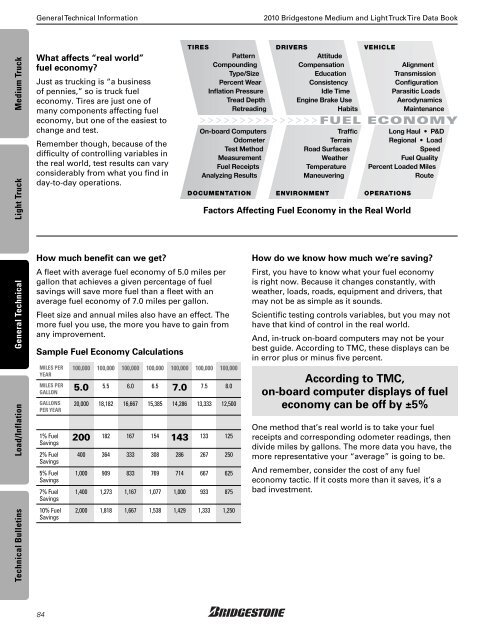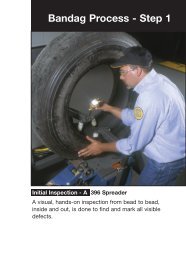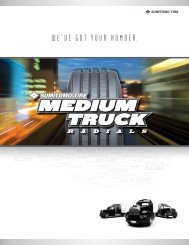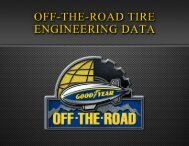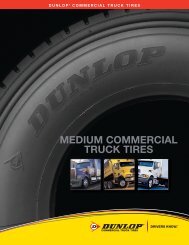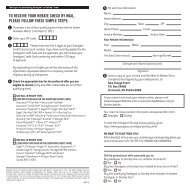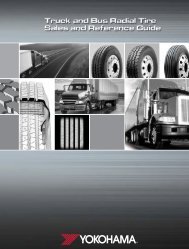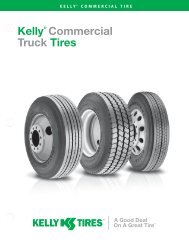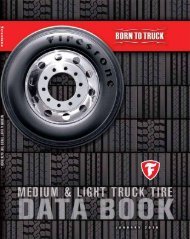Bridgestone Medium and Light Truck Tire Data Book - Sullivan Tire ...
Bridgestone Medium and Light Truck Tire Data Book - Sullivan Tire ...
Bridgestone Medium and Light Truck Tire Data Book - Sullivan Tire ...
Create successful ePaper yourself
Turn your PDF publications into a flip-book with our unique Google optimized e-Paper software.
General Technical Information<br />
2010 <strong>Bridgestone</strong> <strong>Medium</strong> <strong>and</strong> <strong>Light</strong> <strong>Truck</strong> <strong>Tire</strong> <strong>Data</strong> <strong>Book</strong><br />
Technical Bulletins Load/Inflation General Technical <strong>Light</strong> <strong>Truck</strong> <strong>Medium</strong> <strong>Truck</strong><br />
What affects “real world”<br />
fuel economy<br />
Just as trucking is “a business<br />
of pennies,” so is truck fuel<br />
economy. <strong>Tire</strong>s are just one of<br />
many components affecting fuel<br />
economy, but one of the easiest to<br />
change <strong>and</strong> test.<br />
Remember though, because of the<br />
difficulty of controlling variables in<br />
the real world, test results can vary<br />
considerably from what you find in<br />
day-to-day operations.<br />
How much benefit can we get<br />
A fleet with average fuel economy of 5.0 miles per<br />
gallon that achieves a given percentage of fuel<br />
savings will save more fuel than a fleet with an<br />
average fuel economy of 7.0 miles per gallon.<br />
Fleet size <strong>and</strong> annual miles also have an effect. The<br />
more fuel you use, the more you have to gain from<br />
any improvement.<br />
Sample Fuel Economy Calculations<br />
MILES PER<br />
YEAR<br />
100,000 100,000 100,000 100,000 100,000 100,000 100,000<br />
MILES PER<br />
5.0 5.5 6.0 6.5 7.0 7.5 8.0<br />
GALLON<br />
GALLONS<br />
PER YEAR<br />
1% Fuel<br />
Savings<br />
2% Fuel<br />
Savings<br />
5% Fuel<br />
Savings<br />
7% Fuel<br />
Savings<br />
10% Fuel<br />
Savings<br />
20,000 18,182 16,667 15,385 14,286 13,333 12,500<br />
200 182 167 154 143<br />
TIRES<br />
Pattern<br />
Compounding<br />
Type/Size<br />
Percent Wear<br />
Inflation Pressure<br />
Tread Depth<br />
Retreading<br />
DOCUMENTATION<br />
133 125<br />
400 364 333 308 286 267 250<br />
1,000 909 833 769 714 667 625<br />
1,400 1,273 1,167 1,077 1,000 933 875<br />
2,000 1,818 1,667 1,538 1,429 1,333 1,250<br />
DRIVERS<br />
VEHICLE<br />
Attitude<br />
Compensation<br />
Alignment<br />
Education<br />
Transmission<br />
Consistency<br />
Configuration<br />
Idle Time<br />
Parasitic Loads<br />
Engine Brake Use<br />
Aerodynamics<br />
Habits<br />
Maintenance<br />
>>>>>>>>>>>>>>>FUEL ECONOMY<br />
On-board Computers<br />
Odometer<br />
Test Method<br />
Measurement<br />
Fuel Receipts<br />
Analyzing Results<br />
Traffic<br />
Terrain<br />
Road Surfaces<br />
Weather<br />
Temperature<br />
Maneuvering<br />
ENVIRONMENT<br />
Long Haul • P&D<br />
Regional • Load<br />
Speed<br />
Fuel Quality<br />
Percent Loaded Miles<br />
Route<br />
OPERATIONS<br />
Factors Affecting Fuel Economy in the Real World<br />
How do we know how much we’re saving<br />
First, you have to know what your fuel economy<br />
is right now. Because it changes constantly, with<br />
weather, loads, roads, equipment <strong>and</strong> drivers, that<br />
may not be as simple as it sounds.<br />
Scientific testing controls variables, but you may not<br />
have that kind of control in the real world.<br />
And, in-truck on-board computers may not be your<br />
best guide. According to TMC, these displays can be<br />
in error plus or minus five percent.<br />
According to TMC,<br />
on-board computer displays of fuel<br />
economy can be off by ±5%<br />
One method that’s real world is to take your fuel<br />
receipts <strong>and</strong> corresponding odometer readings, then<br />
divide miles by gallons. The more data you have, the<br />
more representative your “average” is going to be.<br />
And remember, consider the cost of any fuel<br />
economy tactic. If it costs more than it saves, it’s a<br />
bad investment.<br />
84


